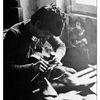The colonnade of St. Peter
Since 1656, Bernini began studying the placement of St. Peter's Square in Rome, a work of paramount importance, which has caused enormous problems, but which was also supported by the full collaboration of Pope Alexander VII Chigi, a cautious and attentive client . The design occupied eleven years of work, and the solutions were developed with continuous improvements.
Bernini began in the summer of 1656, drawing a square shaped like a trapezium, bordered by palaces with arcades to the whole sixth. But the result did not convince the artist who judged the buildings too high and the overall effect somewhat monotonous and not quite spectacular. In the spring of 1657 he had already set up a new project, coming down to defining an oval-shaped square and replacing the porticulated buildings with a colonnade to be trapped.
The slight inclination of the two rectilinear porches in the trapezoidal square allows a more balanced view of the facade, and visually narrows the excessive width. The irregularities in size, symmetry, and all alignment errors between the different elements, facade, obelisk, squares were solved by geometric calculations and illusive perspectives, to make them imperceptible. The same enlargement of the elliptical square space creates a perspective that resizes the excessive width of the facade.
Bernini's choices for all his work were severely criticized in his time, but his colonnade will become a fundamental reference point for modern architecture, the consequences of which will be applied from Italy to all over Europe, to Russia for More than two centuries later.























Double A 31/05/2020 19:51
A very fine and artistic photograph. With the architecture it has a reminiscent feeling of a Piranesi vision. Cheers, Alvinfelipe Martínez Pérez 26/11/2019 0:58
Excelente composición.Gerfried Tamerler 15/11/2017 22:08
I wanna say it a second timevery great pic
congratulation
Gerfried
ClaireLaira 19/09/2017 21:01
Une splendide présentation !Bravo++++
Amitiés, Claire
forgotten Angel 12/08/2017 22:44
An excellent photo !!Best regards
Thomas
Emilio Sirletti 17/07/2017 17:48
Un gioco di luci ed ombre che da un tocco di inquietante mistero all'immagine.Gran bella presentazione.
Ciao, Emilio
alberto16-menuder 06/07/2017 8:39
bellissimaJochen Braband 04/07/2017 22:03
Ein ausgezeichnetes Licht-Schatten-Spiel!Ein Foto mit einer tollen Tiefe!
Sieht hervorragend in SW aus!
Alles Gute, Jochen
Odette LEFEBVRE 04/07/2017 9:44
excellent noir et blanc!Natalia 5 30/06/2017 4:16
Good time! Interesting depth effect! Good luck!Natalia.Anita Jarzombek-Krauledies 29/06/2017 14:28
Exzellent hast Du das Motiv präsentiert! Sehr schönes Licht- und Schattenspiel!Viele Grüße Anita
JOKIST 27/06/2017 21:44
Eine 1A Aufnahme !Ingrid und Hans
ClaireLaira 26/06/2017 11:22
Great perspective and fantastic light mood!Kind regards, Claire
Odette LEFEBVRE 23/06/2017 11:22
très beau jeu d'ombre et de lumière bravoGlo... 22/06/2017 16:50
Una prospettiva stupenda con una bellissima luce!!!!!!! Bravissimo Mirko!